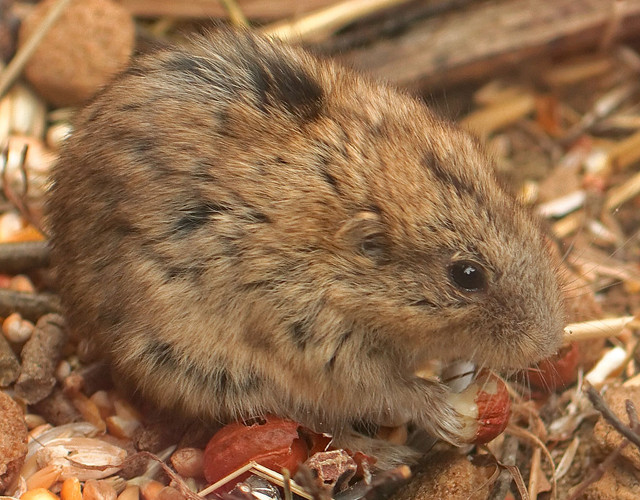
by Ward Chesworth Friday, March 6, 2015

Walt Disney singlehandedly popularized the myth of the mass suicide of lemmings as a standard metaphor for the irrational behavior of crowds. ©russavia, CC BY-NC-SA 2.0.
Long ago, the first step in my doctoral project was to map a Precambrian metamorphic complex in Ontario’s Haliburton Highlands. As a recent immigrant to the country, I was unprepared for the immensity of the forest, and after an exhausting day navigating the Highlands “bush” the old-fashioned way (by pace and compass — GPS was 40 years away), I dreamt that night of a labyrinth of tree trunks with no way out. Years later, I came across Aldous Huxley’s “Wordsworth in the Tropics,” and it re-awoke the panic I’d felt on that early foray. There is something about great forests, wrote Huxley, “which is foreign, appalling, fundamentally and utterly inimical to intruding man … alien to the human spirit and hostile to it.” Is this notion of frightening forests some kind of Darwinian hangover from our early days on the open African savanna?
Huxley contrasts his view with that of the poet George Meredith, who, in his poem “The Woods of Westermain,” tells us that our terror is misplaced “and that if we will but trust Nature we shall find our fears transformed into serenity, joy, and rapture.” That was a foretaste of Walt Disney’s view of nature as expressed in his 1942 animated classic “Bambi.” Walt found the original novel — penned two decades earlier by Austrian writer Felix Salten — too “grim” and “somber,” so he made it more touchy-feely by eliminating naturalistic and environmental elements; and when Disney came to the shooting of Bambi’s mum, he tastefully had it happen off-camera, as anthropomorphic tears rolled from Bambi’s big eyes.
Largely because of Walt, Earth’s biosphere has been one of the abiding “stars” of TV almost from the start. In the 1950s, the Walt Disney Co. played a pioneering role in producing a series of nature documentaries, first shown in cinemas and later on TV. In color, with high-quality production values and brilliant cinematography, Walt took us to places it had once required strenuous and dangerous travel to reach. Spectacular animals in spectacular scenery were presented for consumption like fast food for the eye — as accessible as fried chicken or a Big Mac. The technical standards he set still feature in the best modern wildlife documentaries.
As far as science and veracity are concerned, however, the heritage of such documentaries is less admirable. Fakery also became part of the tradition, which was memorialized 30 years later in the Dead Kennedys’ song “Potshot Heard Round the World” in which they sing:
… those wildlife “documentaries”
Where a lion from a zoo
Kills a deer tied down ahead of time
At the perfect camera angle
When lemmings balk at dying for Disney
They’re just hurled off the cliff…
The last two lines allude to an infamous scene in Disney’s 1958 Academy Award-winning documentary “White Wilderness” in which hundreds of lemmings are seen rushing — apparently of their own volition — across a snow-covered landscape in the far north before throwing themselves into the sea. In fact, the lemmings were shoved off a snow-covered, rotating platform in southern Alberta, Canada, where they fell into the Bow River, which acted as proxy for the Arctic Ocean. Walt singlehandedly popularized the myth of the mass suicide of lemmings as a standard metaphor for the irrational behavior of crowds.
Overall, the Disney organization’s strongest influence on viewers of wildlife TV has been to warp our perception of the realities of nature by laundering out the nastiest bits, in effect giving us a domesticated “wild” that generally conforms to the values of middle-class suburbia.
A well-orchestrated sequence on the badger in “Wild France,” a 2015 episode of the PBS series Nature, illustrates the point. The voice-over coyly tells us that the badger wakes up at 7 a.m., takes care “of some business behind the big tree,” has breakfast, then a brief bath in a stream “followed by a tour of the property.” It’s all reminiscent of Walt’s approach, or even of pre-Disney models such as the Edwardian classic, “Wind in the Willows,” in which a bunch of animals live quintessentially English lives in riverbank holes and burrows kitted out as fully furnished homes, with warm fires and metal scrapers at the door to clean mud off one’s shoes. It’s riparian ecology “cozyfied,” you might say. Nothing could be further from “nature, red in tooth and claw,” which Lord Alfred Tennyson wrote in anticipation of Charles Darwin; or from Huxley’s view of nature as “bottomlessly strange … often hostile and sinister; sometimes even unimaginably, because inhumanly, evil” (although I find “evil” is a value judgment that goes too far).
Throughout history, we have attempted to minimize nature’s scariness by inventing philosophies and religions that replace reality with a safer unreality. We sit tranquilized by TV, like the Simpsons on their couch, viewing nature as a declawed lion, easily cowed by the lion-tamer’s whip and chair. Only occasionally does our innate fear return, when we see news of alligators in Florida, bears in British Columbia, or even tigers in Nepal, invading our urban spaces.
The truth is that we are the invaders, and our urban spaces were once wild habitat that we seized and now hold by being the scariest of all animals in a biosphere that’s implacably Darwinian and terrifying.
© 2008-2021. All rights reserved. Any copying, redistribution or retransmission of any of the contents of this service without the expressed written permission of the American Geosciences Institute is expressly prohibited. Click here for all copyright requests.